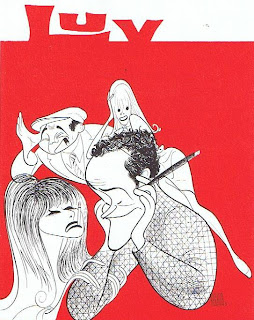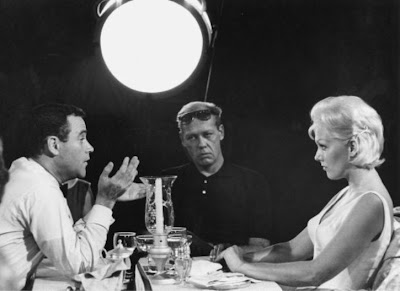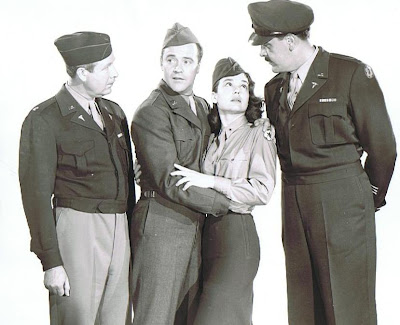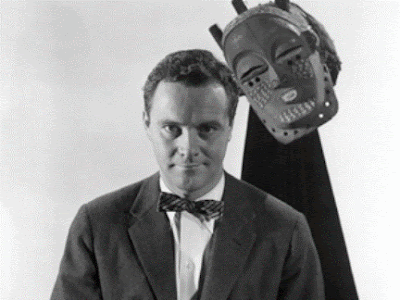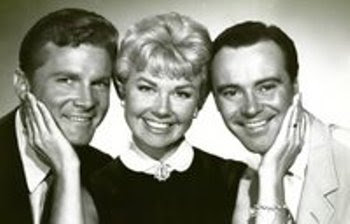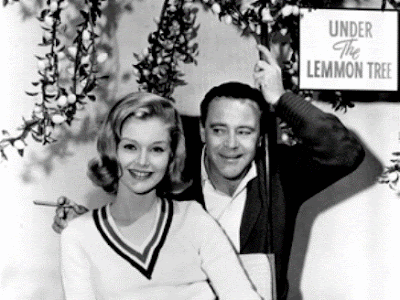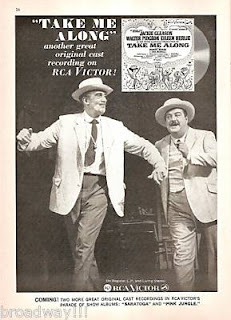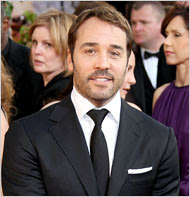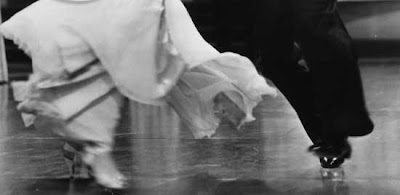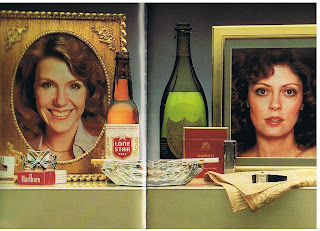
Starting tomorrow, Turner Movie Classics devotes its evening schedule for all four Wednesdays in January to a month-long tribute to Jack Lemmon. Good News. Even better news is the Lemmon title picked by Turner to inagurate this Star of the Month series. No, it isn't the usual suspect. It's not a Billy Wilder film. And it isn't Blake Edwards' "Days of Wine and Roses," blessedly not even part of the series (more about that later).
Here's the schedule for Jack, Part One, airing on Wednesday, 7 January and Thursday, 8 January:
Mark Robson's "Phffft!" (1954), at 8 p.m., est. - Lemmon's second movie to be released - a marital comedy written by playwright George Axelrod that has remained impressively contemporary for more than 50 years now - has always existed, inexplicably so, in the shadows of his first, George Cukor's delightful "It Should Happen to You!" Actually, maybe it's not all that inexplicable, given that Cukor's name always went further in movie-critics circles and among buffs than Robson's ever did.
(
Note: "Phffft!" was actually filmed after "Three for the Show" - see below - which was Jack's second film but whose release was delayed because of censorship problems.)
Nevertheless, both films have one thing in common - uncommonly smart, alert scripts written by people who honed their skills on the stage. ("It Should Happen to You" was penned by Garson Kanin.) Axelrod - the author of the scripts for "The Seven Year Itch" and "The Manchurian Candidate" and the director of "Lord Love a Duck" - came up with sharp, ageless observations as he investigates the disintegration of the marriage of Nina and Robert Tracy (played by Judy Holliday and Lemmon who, of course, were teamed earlier that year in "It Should Happen to You!") and the way it inevitably rebounds. You could call the film post-trendy.
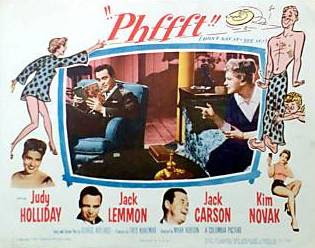

Axelrod's dialogue is a particular treat. That invaluable character actor,
Jack Carson, plays Charlie Anderson, Lemmon's best friend - a confirmed bachelor who forever hands out both bad and interesting dating advice. His lecture on the allure of facial hair provides an excellent case in point:
Charlie: "Grow a moustache. A moustache is very important, It's all part of the famous Charlie Anderson Theory on the Efficacy of Face Hair in Dealing with the Opposite Sex. Sure. Always remember this, Bobby -- dames become unpredictable when faced with a moustache -- it both arouses and angers them -- Being as it is a symbol of masculinity, they feel drawn toward it.
And at the same time, because of envy, they feel inpelled to cause its removal. All men should raise moustaches from time to time." (The italicized words are in Axelrod's script but they were cut from the final film, along with other compelling thoughts on the subject.)
At one point in the film, both the Lemmon and Holliday characters take dance lessons at an Arthur Murray's, only to end up together in the next scene on the dance floor of a nightclub, doing a wickedly hilarous mambo (choreographed by an uncredited Jack Cole, who also designed the dances for "Three for the Show"). Here is a movie moment ever bit as memorable - and as witty - as anything in a Wilder film.
A great way to introduce this Lemmon series - and a great introduction to Lemmon in general. Brave and atypical. The film's full, original title was "Phffft: Chronicle of a Happy Divorce."
Note in Passing: BTW, although Cukor's "It Should Happen to You!" is not officially a part of January's 25-film tribute to Lemmon, Turner Classics will telecast in on Sunday, 1 February at noon, est.
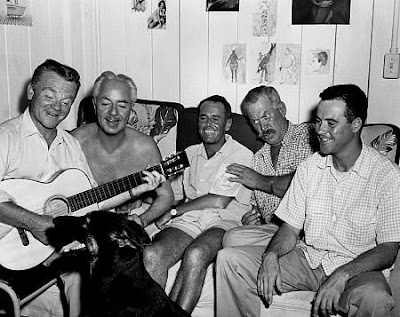 John Ford and Mervyn LeRoy's "Mister Roberts"
John Ford and Mervyn LeRoy's "Mister Roberts" (1955), at 9:45 p.m., est - In 1955, following "It Should Happen to You!" and "Phffft!," Lemmon was scheduled to make his third film, a musical remake of "My Sister Eileen," which was also to be his third film with Judy Holliday (until scheduling bumped her from the film) and his first with a close friend, director Richard Quine, who directed his screen test at Columbia.
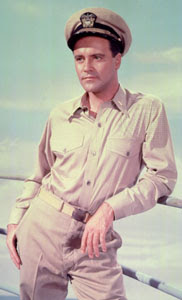
But first came the popular film adaptation of "Mister Roberts," based on the Thomas Heggen book and the Joshua Logan play.
The film of "Mister Roberts," like the play, goes down easy and is very easy to watch, but it also has something of an edge - for me, at least. And I trace that edge to Henry Fonda's performance, which I never found as pleasant or as inspiring as most people.
It's been documented that when Warners was preparing "Roberts" for the screen, Fonda wasn't at the top of its list for the title role, even though he created it on stage. Both William Holden and Marlon Brando (a compelling bit of casting here) were the studio's first choices. Exacerbating matters, the film's original director John Ford, who had a say in the matter, reportedly wanted John Wayne for the role, despite his history with Fonda.

Fonda got the role, of course, but his relationship with Ford was never the same again. Fonda apparently had a lot of complaints about the film - about how Ford had expanded the role played by Ward Bond and how he was directing the seabees in the film to behave like "schoolboys." Ford left the film early - illness being the official reason for his departure - and he was replaced by Mervyn LeRoy, who toughened up the seabees a bit, in the tradition of his Warner gangster films.
Anyway, I may be imaginging it, but Fonda's displeasure with the film seems to seep through and into the movie itself. I don't know much about Hollywood politics but he failed to get an Acadmey Award nomination for his role here - an odd omisson as Fonda must of have seemed like an Oscar shoo-in in 1955.
I don't want to dwell on the wrong thing here of slight Jack's Oscar-winning performance - the month
is devoted to him after all - but I find it fascinating that such a companionable, friendly film had so much unrest behind the scenes. Who knew?
Jack, of course, floats on a comic cloud as Ensign Pulver - his comedy timing here is as light as air and his reading of the line, "I'm looking for marbles all day long," is brilliant. Favorite scene: Roberts (Fonda) and Doc (the irreplacable William Powell) discovering Pulver's arcade pillows...
Doc: "Toujours l'amour ... Souvenir of San Diego ... Oh, you kid!"
Roberts: "Tonight or never ... Compliments of Allis-Chalmers Farm Equipment ... We plow deep while others sleep."
Jack's role was played on stage by David Wayne, and he and Wayne would inevitably star together many years later in Billy Wilder's remake of "The Front Page" (1974).

For the next six hours, Turner has cleverly combined Jack's three film musicals into a sort of mini-festival-within-the-festival. Starting Thursday, 8 January at 12 midnight, est. TCM screens
Richard Quine's "My Sister Eileen" and
H.C. Potter's "Three for the Show" (both from 1955) and
Dick Powell's "You Can't Run Away from It" (a 1956 remake of Frank Capra's 1934 classic, "It Happened One Night").
Quine's "My Sister Eileen" is the pick of the lot here, thanks largely to a pleasing Jule Styne-Leo Robin score, early Bob Fosse choreography (before it became terminally mannered) and a smash lead performance by Betty Garrett (her only real lead), inherited when Judy Holliday had to back out at the last minute. Janet Leigh makes a charming Eileen (and dances well with Fosse) and Jack, in a largely supporting role, has fun with his giddily salicious "Bigger Than Both of Us" solo.
Director Quine started out as an actor and appeared in 25 titles, including Rosalind Russell's original "My Sister Eileen" film (1942), in which he played soda jerk Frank Lippincott, the young man nursing a crush on Janet Blair's Eileen. Thirteen years later, he would direct this film, with the role of Lippincott going to Fosse (billed as
Robert Fosse, incidentally).

"Three for the Show" is familiar stuff - the tale of someone who ends up, inadvertently, with two spouses. Officially, Potter's film is a remake of Wesley Ruggles' 1940 film with Jean Arthur, "Too Many Husbands." Betty Grable has the Arthur role here, with Jack and Gower Champion as her husbands. You've also seen this before in Garson Kanin's 1940 "My Favorite Wife" (with Cary Grant and Irene Dunne) and Michael Gordon's 1965 "Move Over, Darling" (with Doris Day and Jame Garner).
Jack gets to see "How Come You Do Me?" with Grable and dance in two numbers - a competition dance with Gower Champion and a dream ballet set to "Swan Lake." This musical remake is noted largely for Jack Cole's nimble choreography and for having been slammed with the C (condemned) rating from the Catholic Church's Legion of Decency because it was perceived as condoning ... adultry.
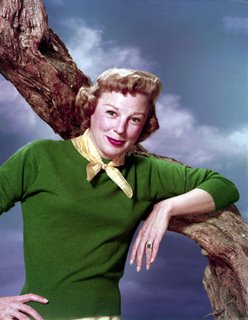
"You Can't Run Away from It" is something of a pseudo-musical remake of "It Happened One Night." By all accounts, this film, a real curisoity, started out as a major production for Columbia Pictures, with Powell – Allyson’s husband, of course – directing a Claude Binyon script that is impressively faithful to the Robert Riskin original and with Jack, fresh off “Mister Roberts,” in the Clark Gable role. Allyson, of course, essayed the original Claudette Colbert part.
The songs, written by Johnny Mercer and Gene DePaul – at least, what’s left of them – are literate and witty. The clever wordplay, for example, between Allyson and Lemmon during the Walls of Jericho number, titled “Temporarily,” has the kind of articulate sophistication that anticipated what Meredith Willson would accomplish, with much more acclaim, in “The Music Man,” a few years later.
But something went wrong, my hunch being that Columbia lost faith in the film – the first clue being the unattractive title that was ultimately attached to the movie. Somewhere along the way, a musical turned into a quasi-musical, with last-minute editing haste evident in the release version.
This is no more apparent than in the “Thumbing a Ride” duet, which is complete on the Decca soundtrack album but truncated on film, with just about all of Lemmon’s savvy lyrics deleted for some bizarre reason. Given that the film’s principals – Allyson, Lemmon and Powell – are all deceased now, one can only speculate what happened.
And it’s unlikely that any of the missing musical footage is sitting on some shelf at Columbia.
Alas, the widescreen film is not being presented letterboxed on Turner (a true rarity) which leads me to believe that "You Can't Run Away from It" has yet to be restored by the people at Sony.
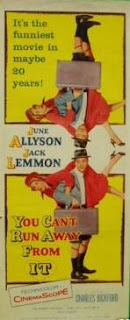 Robert Parrish's "Fire Down Below"
Robert Parrish's "Fire Down Below" (Thursday, 8 January, at 5:30 a.m., est) ends the night on a rather oddball note. This teeming, hothouse drama from 1957, co-starring Robert Mitchum and Rita Hayworth, is inarguably Jack's most atypical film and performance. Jack wrote the "Harmonica Theme" for the film.
Among those notable titles missing from this month-long tribute are the aforementioned "It Should Happen to You!" and "Days of Wine and Roses," along with:

Delmer Dave's very fine "Cowboy" (1958); Blake Edwards' elephantine slapstick "The Great Race" (1965); Stuart Rosenberg's sublime "The April Fools" (1969); Billy Wilder's "The Front Page" (1974); Donald Wyre's Olivier-remake, "The Entertainer" (1976); John Korty's quirky "Alex and the Gypsy" (1976); Bob Clark's film of Jack's play, "Tribute" (1980); Constantin Costa-Gavras' wrenching "Missing" (1982); Glen Jordan's formulic "Mass Appeal" (1984); Ettore Scola's Italian-made "Maccheroni" (1985), with Marcello Mastroianni; Edwards' neglected "That's Life" (1986); Jack's penultimate film (for me, at least), James Foley's "Glengarry Glen Ross" (1992); Harvey Miller's "Getting Away with Murder" (1996), and Martha Coolidge's "Out to Sea" (1997).
Also missing - thankfully - is Mick Jackson's cloying TV film "Tuesdays with Morrie" (1999). As for "Days of Wine and Roses," while it brought Jack a lot of attention (including a well-deserved Oscar nomination), I've always been put off by its facile script. It is really poorly written.
And it hasn't aged well.
(
Artwork: Jack with Judy Holliday and Jack Carson in a scene from Mark Robson's "Phffft!," a colorful lobby card from the black-&-white film and Jack and Judy in another still shot; Lemmon with James Cagney, William Powell, Henry Fonda and Ward Bond behind-the-scenes of "Mister Roberts," Lemmon as the incorrigible Ensign Pulver, and the ad for the film in a 1955 Radio City Music Hall program; a display ad from The New Yorker magazine for the run of "My Sister Eileen" at Gotham's Victoria Theatre; poster art for "Three for the Show" and "Fire Down Below"; June Allyson, beaming in color by Technicolor in "You Can't Run Away from It," and the poster art for Dick Powell's film)
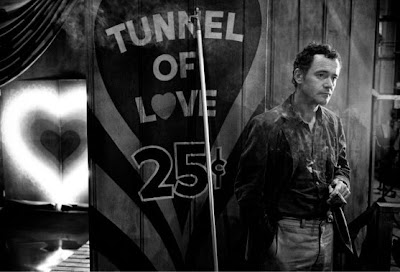
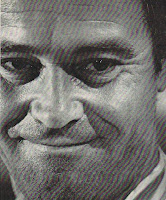 Jack Lemmon's career, by my count, went through four stages.
Jack Lemmon's career, by my count, went through four stages.
